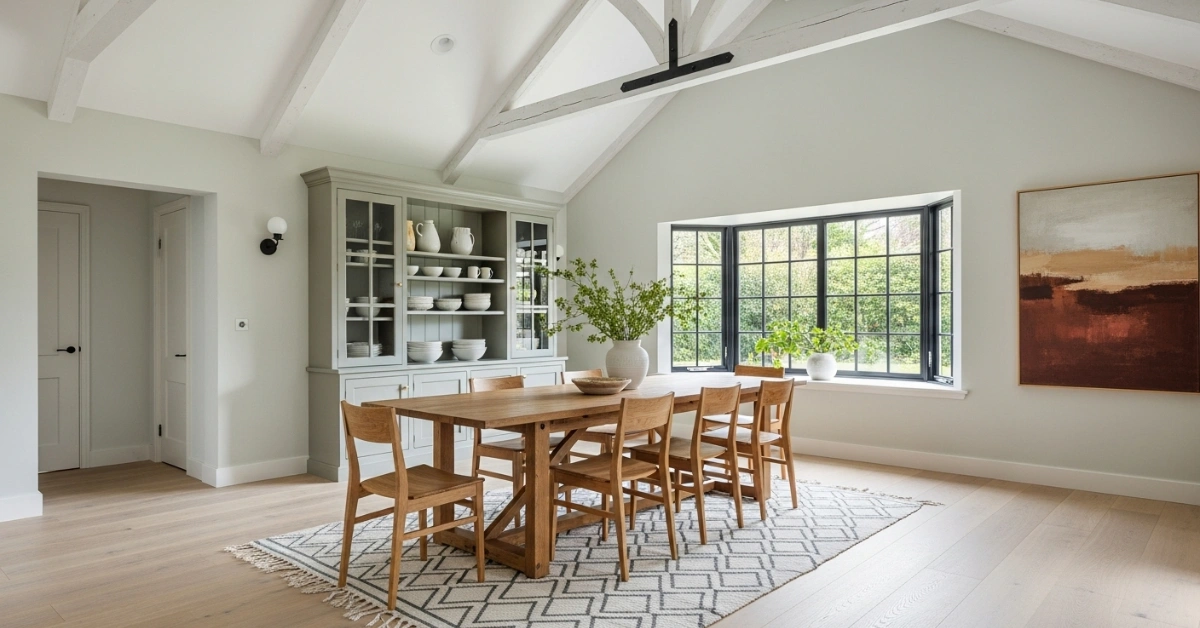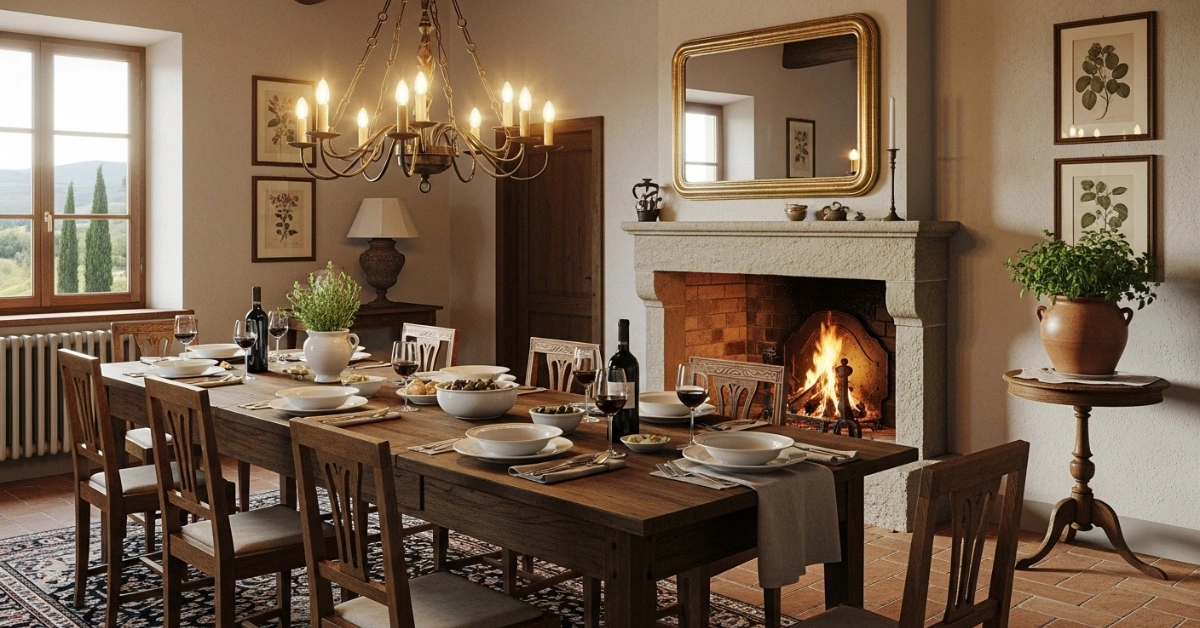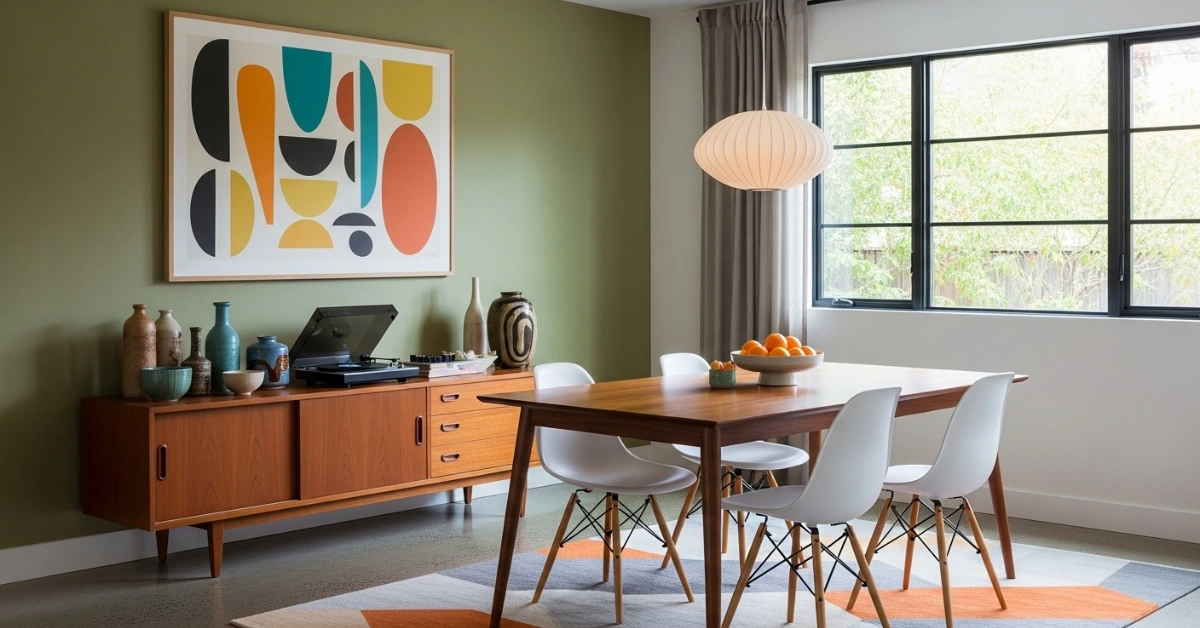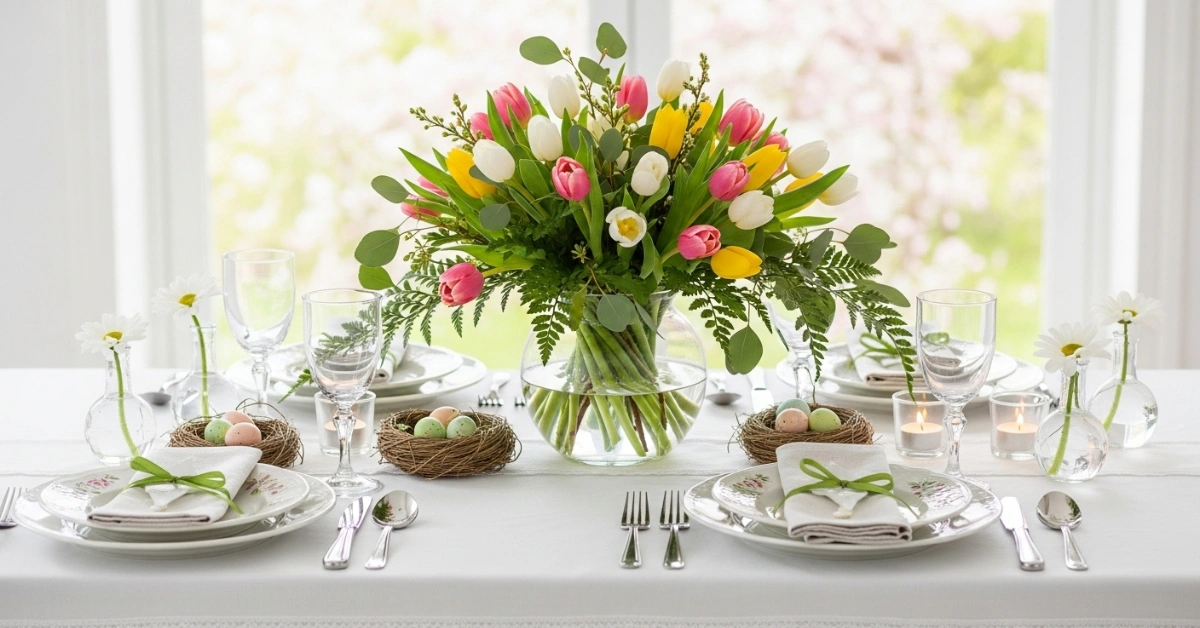32 Ideas for a Stylish Dark Dining Room Design

A dimly lit or poorly designed dark dining room can feel uninviting, making meals less enjoyable and gatherings awkward. The wrong color palette or lack of balance can turn a potentially elegant space into one that feels heavy or dated. Fortunately, a well-executed dark dining room can be warm, sophisticated, and unforgettable. By blending rich hues, strategic lighting, and thoughtful textures, you can transform your dining space into a cozy yet luxurious haven that impresses guests and elevates everyday dining.

What Makes a Dark Dining Room Special?
A dark dining room stands out for its bold, dramatic aesthetic. Unlike lighter spaces, it creates an intimate atmosphere perfect for evening gatherings or formal dinners. According to a 2023 survey by Houzz, 68% of homeowners prefer moody, darker tones for dining areas to evoke elegance. The key is balancing depth with warmth to avoid a cold or oppressive feel.

The Psychology of Dark Colors
Dark tones like charcoal, navy, or deep green evoke calmness, sophistication, and focus. “Dark colors make a room feel grounded, like a cocoon that encourages connection,” says interior designer Emily Harper, who specializes in moody interiors. However, overuse without balance can feel overwhelming, so strategic design choices are critical.

Benefits of a Dark Dining Room
- Intimacy: Darker hues create a cozy, enclosed feel, ideal for conversations.
- Versatility: Pairs well with modern, traditional, or eclectic styles.
- Timeless Appeal: Dark tones remain stylish across design trends.

Choosing the Perfect Dark Color Palette
Selecting the right colors sets the foundation for your dark dining room. Aim for hues that feel rich but not overpowering. Here are some top choices:
- Charcoal Gray: Sleek and modern, it pairs well with metallics.
- Navy Blue: Timeless and calming, ideal for coastal or classic styles.
- Forest Green: Organic and warm, perfect for nature-inspired designs.
- Deep Plum: Luxurious and bold, great for eclectic or bohemian vibes.
- Matte Black: Ultra-modern and dramatic, best for minimalist spaces.

Tips for Selecting Your Palette
- Test Samples: Paint swatches on your walls and observe them in different lighting.
- Consider Undertones: Warm undertones (e.g., red-based grays) add coziness.
- Balance with Neutrals: Pair dark walls with lighter accents to avoid heaviness.
Lighting: The Key to a Welcoming Dark Dining Room
Lighting can make or break a dark dining room. Poor lighting amplifies gloom, while thoughtful fixtures enhance warmth and elegance. “Layered lighting is essential in a dark dining room to create depth and functionality,” says lighting designer Mark Sullivan.

Types of Lighting to Include
- Ambient Lighting: A central chandelier or pendant light sets the mood. Opt for warm-toned bulbs (2700K–3000K).
- Task Lighting: Wall sconces or table lamps illuminate specific areas for dining or reading.
- Accent Lighting: LED strips or picture lights highlight artwork or architectural details.

Lighting Placement Tips
- Hang chandeliers 30–36 inches above the dining table for optimal illumination.
- Use dimmable lights to adjust the mood for casual or formal occasions.
- Place sconces at eye level (about 5–6 feet from the floor) for balanced lighting.

Real-World Example
In a recent project, I helped a client transform their navy dining room by installing a brass chandelier and recessed LED lights. The warm glow softened the dark walls, making the space feel inviting for both family dinners and parties.
Furniture Choices for a Dark Dining Room
Your furniture should complement the dark aesthetic while adding contrast and comfort. Here’s how to choose wisely:

Dining Table Options
- Wood Tones: Oak or walnut tables add warmth against dark walls.
- Glass or Marble: Reflective surfaces lighten the space and add elegance.
- Metal Accents: Brass or gold-trimmed tables enhance luxury.

Chair Styles
- Upholstered chairs in neutral tones (beige, cream) balance dark walls.
- Velvet or leather adds texture and sophistication.
- Avoid overly dark furniture to prevent a monotonous look.

Table: Furniture Pairings for Dark Dining Rooms
| Wall Color | Table Material | Chair Style | Accent Color |
|---|---|---|---|
| Charcoal Gray | Oak Wood | Beige Upholstered | Gold |
| Navy Blue | Glass | White Leather | Silver |
| Forest Green | Walnut | Cream Velvet | Brass |
| Deep Plum | Marble | Gray Linen | Rose Gold |
Textures and Materials to Elevate the Space
Textures prevent a dark dining room from feeling flat. Mix materials to add depth and visual interest.
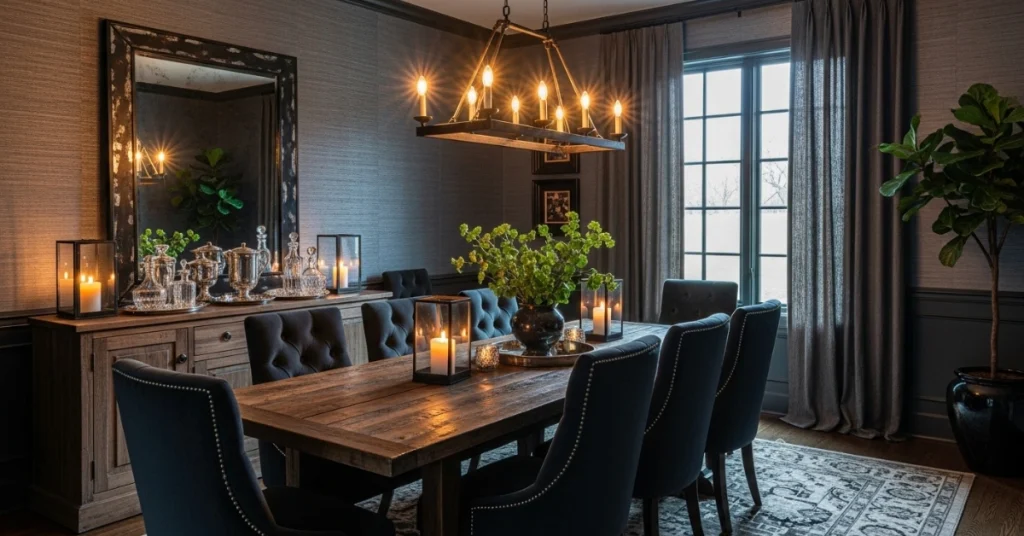
Popular Textures
- Velvet: Soft and luxurious, ideal for curtains or upholstery.
- Wood: Adds organic warmth to tables or shelving.
- Metallics: Brass, gold, or silver accents (e.g., cutlery, vases) reflect light.
- Linen: Light, airy fabrics for table runners or napkins.

How to Incorporate Textures
- Use a plush area rug under the dining table to ground the space.
- Add metallic wall art or mirrors to bounce light and add sparkle.
- Layer table settings with linen napkins and ceramic dishware for a tactile experience.

Wall Treatments and Decor Ideas
Dark walls are a statement, but they need thoughtful decor to shine. Here are some ideas:

Wall Treatments
- Matte Paint: Absorbs light for a cozy, understated look.
- Glossy Finish: Reflects light, adding a modern edge.
- Wallpaper: Textured or patterned wallpaper (e.g., damask or botanical) adds personality.

Decor Tips
- Hang a large mirror to reflect light and make the room feel larger.
- Display bold artwork with vibrant colors to contrast dark walls.
- Use floating shelves to showcase ceramics or greenery.

Designer Insight
“Mirrors are a game-changer in dark dining rooms,” says designer Laura Bennett. “They double the light and make the space feel expansive without losing the moody vibe.”

Incorporating Greenery and Natural Elements
Plants bring life to a dark dining room, softening the intensity of the color scheme. According to a 2024 study by the American Society of Interior Designers, 72% of homeowners report that indoor plants improve their mood and space aesthetics.

Best Plants for Dark Dining Rooms
- Snake Plant: Thrives in low light and adds vertical interest.
- Pothos: Trailing vines look stunning in hanging planters.
- Ferns: Lush and green, perfect for corners or centerpieces.
Placement Ideas
- Place a tall plant in a corner to add height.
- Use a centerpiece of low-maintenance succulents for the dining table.
- Hang macramé planters near windows to catch natural light.
Balancing Dark and Light Elements
A successful dark dining room balances moody tones with lighter accents to avoid a heavy feel. Here’s how:

Light Accents to Include
- Neutral Textiles: Beige or white curtains lighten the mood.
- Metallic Fixtures: Gold or silver candlesticks or trays add shine.
- Bright Artwork: Bold colors or white frames pop against dark walls.
Practical Example
In a forest-green dining room project, we paired dark walls with cream linen curtains and a gold-framed mirror. The result was a balanced, airy space that still felt luxurious.
Common Mistakes to Avoid
Even with the best intentions, dark dining rooms can go wrong. Here are pitfalls to sidestep:
- Overloading with Dark Tones: Too much dark furniture or decor can feel oppressive.
- Poor Lighting: Insufficient or cold lighting makes the space feel gloomy.
- Ignoring Texture: Flat surfaces without texture look lifeless.
- Cluttered Decor: Too many accessories can overwhelm a small space.
How to Fix These Issues
- Mix in light furniture or accents to break up dark tones.
- Invest in warm, layered lighting (e.g., chandeliers, sconces).
- Add textured elements like rugs or upholstered chairs.
- Keep decor minimal and purposeful for a clean look.
Inspiration from Real Dark Dining Room Designs
Let’s look at a few real-world examples for inspiration:
Modern Minimalist
A charcoal gray dining room with a sleek glass table, white leather chairs, and a single brass chandelier. The simplicity keeps it chic and timeless.

Bohemian Elegance
A deep plum dining room with a walnut table, velvet chairs, and eclectic wall art. Potted plants and woven rugs add warmth and character.

Classic Coastal
A navy blue dining room with a white marble table, beige upholstered chairs, and nautical decor. The light accents keep it fresh and inviting.

Budget-Friendly Tips for a Dark Dining Room
You don’t need a big budget to create a stunning dark dining room. Here are cost-effective ideas:
- Paint Over Wallpaper: A gallon of high-quality paint costs $30–$50 and transforms walls.
- Thrift Furniture: Look for secondhand tables or chairs to refinish.
- DIY Decor: Create your own wall art or table centerpieces with affordable materials.
- Shop Sales: Retailers like West Elm or IKEA often have discounts on lighting and accessories.

Maintaining Your Dark Dining Room
A dark dining room requires upkeep to stay pristine. Here’s how to maintain it:
- Clean Walls Regularly: Dust and smudges show up easily on dark paint. Use a damp cloth with mild soap.
- Protect Furniture: Use coasters and tablecloths to prevent scratches or stains.
- Refresh Lighting: Replace bulbs every 1–2 years to maintain brightness.
- Rotate Decor: Swap out artwork or plants seasonally to keep the space fresh.

Conclusion
A dark dining room is more than just a design choice, it’s a statement of elegance and intimacy. By carefully selecting colors, layering lighting, and incorporating textures, you can create a space that’s both inviting and unforgettable. Whether you’re hosting a dinner party or enjoying a quiet meal, your dark dining room will set the perfect mood.
Ready to create your dream dark dining room? Start by picking one tip from this guide, whether it’s choosing a bold color or adding a statement chandelier and transform your space today. Share your progress in the comments or consult a local designer for personalized advice!


